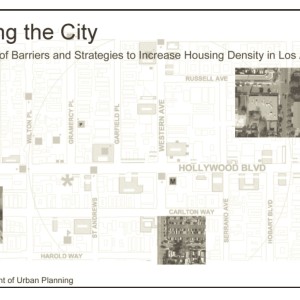
Authors: Marcelle Watson Boudreaux, Hsin-Hsin (Diana) Chang, Stephanie Cheng, John Kamp, Bernard Lee, Jeremiah Lee, Christine Mahfouz, Alissa Marquez, Teresa J. Mitchell, Steven Patton, Victoria Ramírez, Paola J. Ruvalcaba, Erika J. Villablanca , Sarah White
Date: June 1, 2005
Project: [wpv-post-link id=”$project”]
Although housing density is an objective measure it raises a range of subjective perceptions and interpretations. Overall, density is largely perceived by communities as having a negative impact on the quality of life within the City of Los Angeles. As evident in community groups and council meetings, most people are adamantly against growth, particularly within their neighborhoods. Such animosity is representative of fear which is typically struck by thoughts of overcrowding, worsened traffic congestion, environmental pollution, increased noise, and fear of attracting the wrong types of users. On the other side of the spectrum we often find that practitioners in the field of planning and development, who in effect are largely responsible for guiding the future growth of communities believe that higher density living has numerous environmental, social and economic advantages.
In spite of most public perceptions, the Los Angeles urbanized region (the metropolitan area) is the densest metropolitan region in the country. However, this aggregate picture also hides certain morphological aspects of, and variations in, the city’s density. Furthermore, the city has one of the lowest home ownership rates in the nation and housing supply and affordability is a significant, policy problem. Thus, the real challenge that confronts individuals guiding the development of our communities is the implementation of programs and policies that clearly plan for the region’s growth in a manner that efficiently utilizes existing resources as well as increases opportunities to house all Angelenos.
Our research was guided by the in-depth analysis of a study area within Council District 13 in East Hollywood. Executive Summary Our study area is defined by Franklin Avenue on the north, Sunset Boulevard on the south, Normandie Avenue on the east, and Bronson Avenue and US Highway 101 on the west. We selected this area because it presents an excellent opportunity to look at the challenges of developing higher density housing since it encompasses a major transit and commercial corridor, has a limited amount of available land on which to develop, and is also located in the midst of a residential zone.
Link to Publication